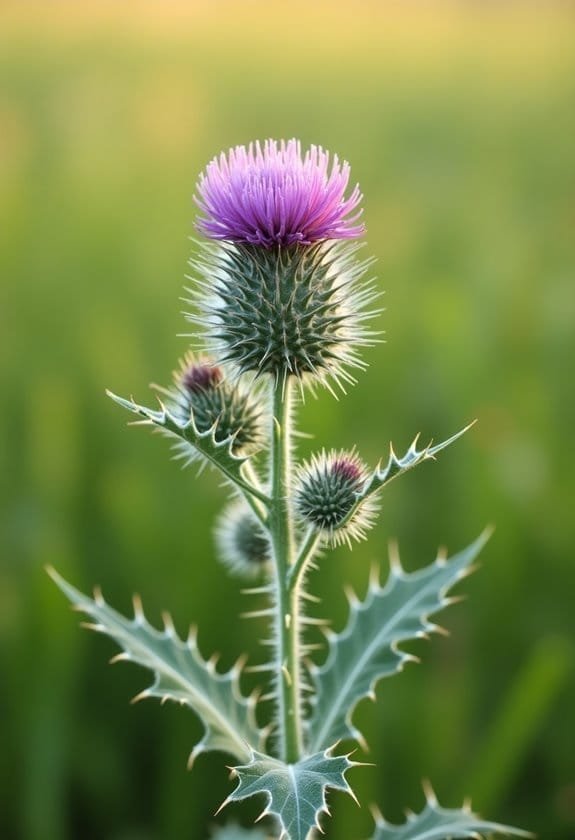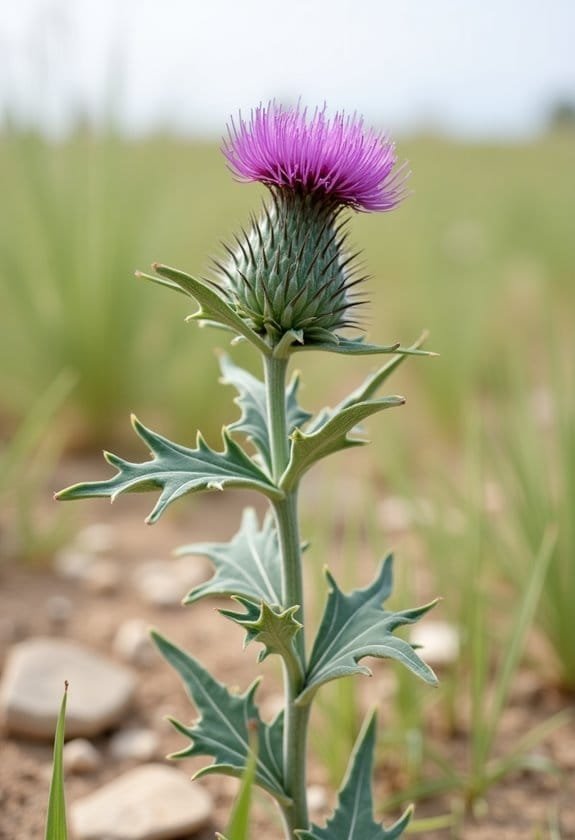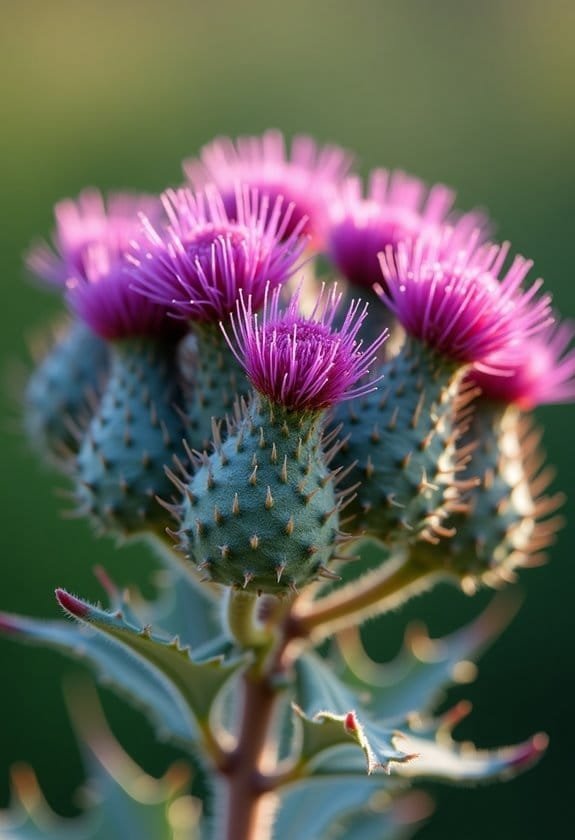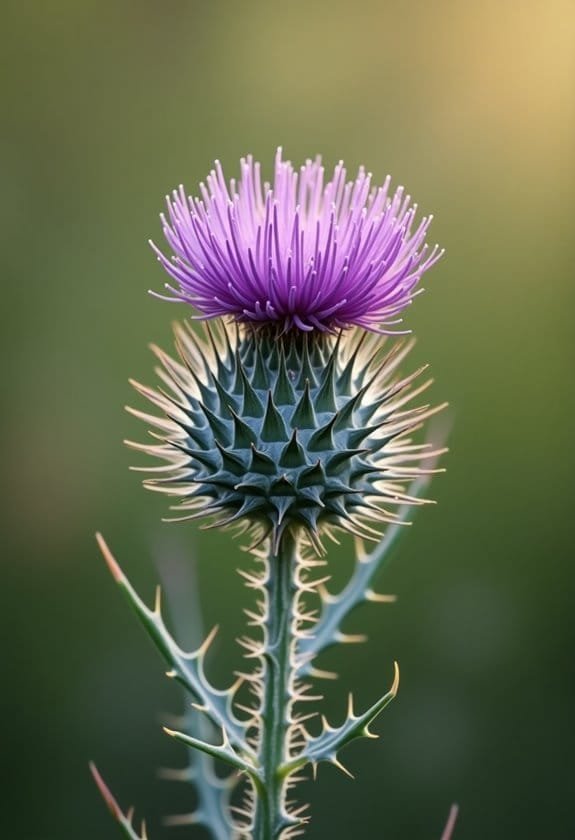Welted thistle (Carduus crispus) is an aggressive invasive plant that's made its mark across North America since 1974. The plant reaches heights of 1-5 feet, featuring distinctive wrinkled leaves with spiny margins spanning 10-20 cm and hairy stems adorned with wings up to 1.5 cm wide. Its purple, pink, or white flower heads bloom from July to September, measuring 15-18 mm across and attracting various pollinators. While it thrives in full sun and moist, well-drained soils, this resilient thistle poses significant agricultural challenges through its rapid spread and impact on forage quality. Understanding its growth patterns reveals effective management strategies for control.
Main Points
- Welted thistle is an invasive plant in the Asteraceae family, growing 1-5 feet tall with spiny wings and purple-pink flowers.
- The plant blooms from July to September, producing wind-dispersed seeds and requiring insect pollination for reproduction.
- It thrives in full sunlight and moist, well-drained soils, commonly found along irrigation ditches and disturbed habitats.
- Control methods include regular mowing, hand-pulling, selective herbicide application, and establishing competitive cover crops.
- First appeared in the U.S. in 1974 and poses agricultural concerns by impacting forage quality in hay fields.
Introduction

Welted thistle (Carduus crispus) stands as a formidable Eurasian plant that has established itself in North American ecosystems since its first U.S. appearance in 1974.
This resilient member of the thistle family commands attention with its impressive height of 1 to 5 feet, featuring distinctive spiny-winged stems and crowned with clusters of purple, pink, or white blooms.
As a biennial to annual plant, it has become a significant presence in disturbed landscapes, where its adaptable nature and robust growth pattern have earned it both agricultural concern and ecological interest.
Common Name
The spiny plant commonly known as welted thistle (Carduus crispus) is also referred to as curly plumeless thistle throughout its range. This distinctive member of the Carduus genus earned its primary common name from the characteristic welted or wrinkled appearance of its stems and foliage, which sets it apart from similar species in the thistle family.
The name "curly plumeless thistle" derives from the plant's remarkably twisted leaves and the absence of long, feathery structures called pappus that are typically found in related thistle species.
While both common names are widely accepted in scientific literature, welted thistle has become the predominant term, particularly in regions where it's considered an invasive species.
Agricultural communities often use these common names interchangeably when discussing its impact on hay fields and pastureland, where its presence can greatly reduce forage quality.
The plant's recognition as a problematic invasive species has led to increased familiarity with both common names among land managers and agricultural professionals, who must remain vigilant in identifying and controlling its spread.
Scientific Name
Scientifically classified as Carduus crispus, this invasive thistle belongs to the extensive Asteraceae family, which includes sunflowers, daisies, and numerous other composite flowers. The genus name Carduus, rooted in Latin terminology, specifically denotes a distinctive type of thistle, while crispus refers to the plant's characteristically wavy or curled features.
The welted thistle's scientific nomenclature provides vital insights into its taxonomic relationship with other similar species, particularly its close relative Carduus acanthoides, the spiny plumeless thistle. Though native to Eurasia, Carduus crispus has established itself as a significant presence in North American ecosystems since its first documented appearance in 1974.
This scientific classification helps researchers and botanists track its distribution and study its ecological impact across different regions.
The plant's binomial name also serves as a reference point for understanding its life cycle patterns, as it completes its development either annually or biennially, producing its distinctive blooms during the late summer months from July through September.
Overview
Towering up to five feet tall, this invasive thistle species stands as a formidable presence in disturbed habitats across North America. The Welted thistle, first documented in the United States in 1974, has rapidly established itself as a concerning ecological challenger in various environments, particularly along roadsides and within agricultural settings.
Distinguished by its openly branching structure and distinctive hairy stems adorned with spiny wings, Carduus crispus showcases its reproductive prowess through vibrant flower heads that bloom in shades of purple, pink, or white during the late summer months.
The plant's Latin name reflects its physical characteristics, with "crispus" aptly describing its wavy, undulating features.
As a noxious weed in numerous regions, this European and Asian native poses significant challenges to agricultural operations, particularly affecting the quality of grass and alfalfa hay production.
Its reliance on insect pollination hasn't hindered its successful spread, as it continues to thrive in disturbed landscapes, demonstrating remarkable adaptability and persistence in its adopted territories.
Key Features
Welted thistle stands as a striking plant, reaching heights between 1 to 5 feet with distinctive hairy stems adorned by spiny wings that extend up to 1.5 centimeters wide.
Its spiny-toothed leaves alternate along the stem in lengths of 10 to 20 centimeters, creating a formidable defensive arrangement characteristic of thistle species.
The plant's disk-shaped flower heads burst into vibrant displays of purple, pink, or white blooms measuring 15-18 millimeters across during its peak flowering period from July through September.
Growth Size
A distinctive member of the thistle family, Carduus crispus exhibits considerable variation in its growth size, typically reaching heights between 1 to 5 feet, though exceptional specimens can stretch up to 10 feet tall. The welted thistle's impressive vertical development is complemented by its substantial lateral growth, featuring openly branching stems adorned with prominent spiny wings.
The plant's structural elements display remarkable proportions throughout its framework. Its leaves extend between 10 to 20 centimeters in length, creating an imposing silhouette enhanced by their spiny-toothed margins and distinctively winged petioles.
The flower heads, while relatively modest in comparison to the plant's overall stature, measure 15 to 18 millimeters in width, appearing in vibrant shades of purple, pink, or white. The stem's spiny wings, reaching up to 1.5 centimeters in width, are armed with 3-millimeter spines that contribute to the plant's formidable presence.
This thorough size profile, from its towering height to its intricate defensive structures, establishes the welted thistle as a commanding presence in its native habitats.
Appearance
Beyond its impressive stature, the welted thistle showcases distinct physical features that make it instantly recognizable in the field. Its most notable characteristic is the stem's spiny wings, which extend up to 1.5 centimeters wide and are armed with sharp 3-millimeter spines that serve as natural deterrents to herbivores.
The leaf blades of this remarkable plant display a fascinating combination of textures, featuring both elongated curling hairs and a subtle layer of woolly pubescence. These alternating leaves, measuring 10 to 20 centimeters in length, can appear either lobed or unlobed, with their margins adorned with distinctive spiny teeth that complement the plant's defensive architecture.
During its flowering period from July through September, the welted thistle produces elegant disk-shaped flower heads that measure 15 to 18 millimeters in diameter. These blooms exhibit a variety of colors, ranging from deep purple to delicate pink and pristine white, creating a striking visual display against the plant's robust green foliage and spiny exterior.
Flowering Season
During the height of summer, robust clusters of flowering heads emerge across the welted thistle's spiny branches, marking its peak reproductive period from July through September.
These distinctive blooms, measuring 15-18 millimeters in diameter, appear either solitarily or in intimate groupings of two to five flowers, creating a striking display that attracts numerous pollinators.
The welted thistle's flowering season strategically coincides with maximum pollinator activity, ensuring ideal conditions for successful reproduction. Its hermaphroditic flowers, which can manifest in shades of purple, pink, or white, rely entirely on insect pollination to complete their reproductive cycle.
Following successful pollination, the plant's seeds begin to mature, reaching ripeness by late July.
As the flowering season progresses, the welted thistle employs an efficient wind-dispersal mechanism for its seeds.
This temporal alignment of flowering, pollination, and seed dispersal demonstrates the plant's well-adapted reproductive strategy, allowing it to complete its annual or biennial life cycle effectively while maximizing its chances for successful propagation across diverse landscapes.
Growing Requirements

Welted thistle's growing requirements reflect its adaptable yet specific nature, with its strong preference for full sunlight being essential for robust growth and flowering.
The plant demonstrates remarkable soil versatility, establishing itself in various soil types while showing particular vigor in consistently moist conditions that can range from slightly acidic to alkaline pH levels.
These hardy plants thrive in temperatures typical of temperate climates, where summer warmth supports their July-to-September blooming period and facilitates successful seed dispersal through seasonal winds.
Light
The growing requirements for light are straightforward for this hardy thistle – it demands full sunlight to achieve ideal growth. When establishing itself in disturbed areas like roadsides and fields, welted thistle capitalizes on unobstructed access to direct sunlight, which proves essential for its robust development and successful reproduction.
This sun-loving plant's preference for open spaces aligns perfectly with its colonizing nature, as it readily establishes itself in areas where competing vegetation has been removed or disturbed. The absence of shade tolerance in welted thistle explains its notable absence from woodland edges and forested regions, where canopy coverage would inhibit its growth potential.
During the peak blooming months of July through September, the plant's positioning in full sunlight maximizes its exposure to pollinators, ensuring successful reproduction. This strategic timing coincides with periods of intense solar radiation, allowing the plant to harness favorable light conditions for photosynthesis and energy production.
In environments where light competition exists, welted thistle typically demonstrates reduced vigor and may fail to establish successful populations.
Soil
Much like its need for abundant sunlight, soil conditions play a key role in welted thistle's successful establishment. This resilient plant demonstrates remarkable adaptability across diverse soil types, thriving particularly well in well-drained environments where competing vegetation is minimal. Its capacity to flourish in various pH levels further enhances its colonizing abilities.
Welted thistle's preference for disturbed habitats has made it a particularly successful colonizer of human-modified landscapes, where it can establish robust populations in areas such as roadsides, abandoned fields, and waste grounds.
The plant's ability to adapt to fluctuating moisture levels, combined with its tolerance for different soil compositions, enables it to maintain healthy growth even when environmental conditions aren't ideal. This adaptability has ecological implications, as the species often gains a competitive advantage over native flora in disturbed soils.
While this characteristic makes welted thistle a concerning invasive species in some regions, it also demonstrates the plant's remarkable evolutionary success in exploiting niches created by anthropogenic disturbance, particularly in areas where soil conditions have been altered by human activities.
Water
Adequate water supplies play an essential role in welted thistle's life cycle and reproductive success. The plumeless thistle demonstrates a marked preference for consistently moist, well-drained soils, which directly influences its ability to establish robust populations in disturbed habitats. These moisture requirements align perfectly with its common occurrence along irrigation ditches and field margins, where water availability remains relatively stable throughout the growing season.
The plant's relationship with water extends beyond basic survival needs, as moisture levels greatly impact its competitive advantage over native species. During its peak blooming period from July through September, welted thistle requires reliable water access to support both flowering and subsequent seed dispersal mechanisms.
Despite its moisture requirements, the thistle's need for full sunlight exposure creates a delicate balance in its water management strategy. In areas where water resources are abundant, the plant often establishes dense stands that can effectively outcompete surrounding vegetation.
This adaptability to wet conditions, combined with its inability to tolerate shade, makes water availability a vital factor in determining the thistle's distribution patterns and overall success in colonizing new territories.
Temperature
Beyond moisture requirements, welted thistle's growth depends heavily on specific temperature conditions. This adaptable plant has evolved to thrive in the warm temperatures typical of summer months across North America, particularly during its vital blooming phase from July through September.
Temperature plays a significant role in both the plant's vegetative growth and reproductive success, as thermal conditions influence seed germination rates and subsequent establishment.
Welted thistle demonstrates remarkable temperature resilience, though it performs best when daytime temperatures consistently reach 20-25°C (68-77°F). During its active growing season, the plant requires sustained warmth to develop its characteristic rigid stems and deeply lobed leaves.
The species' temperature requirements align perfectly with its bloom timing, ensuring that flowering coincides with periods of maximum pollinator activity.
Cool spring temperatures trigger initial growth, while summer warmth promotes robust development and successful seed production. When temperatures drop below ideal levels, welted thistle's growth rate typically slows, though the plant can withstand brief periods of cooler conditions without significant damage to established specimens.
Pollinator Criteria
Welted thistle serves as a essential nectar source for diverse pollinators, particularly bees and butterflies, during its peak flowering period from July through September.
The plant's distinctive purple, pink, or white flower heads, measuring 15-18 mm in width, create an inviting platform for insect visitors seeking sustenance.
Its openly branching architecture functions as an extensive pollinator highway system, allowing multiple species to access nectar simultaneously while facilitating successful cross-pollination throughout disturbed habitats.
Attracted Pollinators
Supporting diverse pollinator populations, Carduus crispus blooms from July through September when insect activity reaches its peak. The welted thistle's purple, pink, or white flowers serve as prominent beacons for various beneficial insects, particularly during the warmest months of the year.
Its open, branching structure creates an accessible platform for pollinators to navigate between numerous flower heads. The plant's reproductive success depends entirely on insect-mediated pollination, as Carduus crispus reproduces exclusively through seed production.
Among its most significant visitors are various bee species, which efficiently transfer pollen between individual plants while gathering nectar. The thistle holds special ecological importance as a host plant for the painted lady butterfly (Vanessa cardui), providing essential nutrition for its developing caterpillars.
This relationship exemplifies the plant's role in supporting not just adult pollinators but also their offspring. The synchronized timing of the thistle's flowering period with peak pollinator activity demonstrates an evolutionary adaptation that maximizes reproductive success while ensuring reliable food sources for its insect partners.
Pollination Method
Essential to its reproductive success, Carduus crispus relies exclusively on insect pollination to produce viable seeds. The Welted thistle's reproduction strategy perfectly aligns with the peak activity of various pollinating insects during its flowering period from July through September. Its distinctive flower heads, measuring 15-18 mm in width, showcase vibrant purple, pink, or white blooms that serve as natural beacons for passing pollinators.
The intricate relationship between Welted thistle and its insect pollinators demonstrates a fascinating ecological interdependence. As insects visit the flower heads to collect nectar, they inadvertently transfer pollen between plants, ensuring successful cross-pollination and subsequent seed production.
This process is particularly vital because the plant reproduces solely through seeds, making effective pollination a cornerstone of its survival strategy. Once pollination occurs and seeds develop, the plant's reproduction cycle shifts to wind-based seed dispersal, allowing mature seeds to travel considerable distances.
This dual mechanism of insect pollination followed by wind dispersal highlights the species' evolutionary adaptation to maximize reproductive success in disturbed habitats.
Care & Maintenance

Effective management of welted thistle requires careful attention to both its preferred growing conditions and potential impact on surrounding vegetation.
While mechanical control methods like regular mowing and hand-pulling serve as primary maintenance strategies, maintaining healthy soil conditions and promoting diverse plant communities can naturally suppress thistle establishment.
Chemical treatments should be considered as a last resort, with targeted herbicide applications carefully timed before seed production to minimize impact on beneficial neighboring plants.
Planting Tips
Growing welted thistle requires careful attention to three key maintenance aspects: proper soil preparation, sunlight exposure, and strategic control measures. The plant's successful establishment hinges on creating well-drained soil conditions that promote robust root development while preventing waterlogging issues.
For peak growth management, select locations that receive full sunlight throughout the day, as welted thistle thrives in bright, open spaces. When preparing growth areas, verify the soil is loosened to a depth of 8-10 inches, incorporating organic matter to enhance drainage capabilities.
While the plant's adaptability makes it relatively easy to establish, this same trait necessitates vigilant monitoring to prevent unwanted spread.
To maintain controlled growth, implement a rotating schedule of mechanical and chemical management techniques. This approach includes regular mowing before seed formation, typically in late spring, and selective herbicide application when necessary.
Incorporating cover crops in adjacent areas can create natural barriers, effectively limiting the thistle's expansion while promoting beneficial soil biology. Remember to maintain a 3-foot buffer zone between plantings to facilitate easier access for maintenance activities.
Ongoing Care
Successful management of welted thistle demands vigilant monitoring and a combination of control methods throughout its growing cycle. Regular assessment of plant populations helps identify potential spread issues before they become significant problems, particularly in areas where native flora could be threatened by thistle encroachment.
For effective ongoing care, implementing a multi-faceted approach is essential. Mechanical removal, including hand-pulling and strategic mowing before seed development, serves as the primary defense against welted thistle establishment.
When chemical control becomes necessary, carefully timed herbicide applications can supplement mechanical methods, though practitioners must strictly adhere to local guidelines to protect beneficial plants.
Cultural management practices play a fundamental role in long-term thistle suppression. Incorporating cover crops and maintaining proper crop rotation schedules helps create an environment where welted thistle struggles to establish dominance.
It's important to stay informed about regional regulations regarding noxious weed control, as these guidelines often provide specific requirements for management timing and approved control methods. Regular soil health maintenance further supports an integrated approach to thistle control.
Suggested Companions
While managing welted thistle requires careful attention, choosing appropriate companion plants can greatly enhance its cultivation. The plumeless thistle particularly thrives when surrounded by nitrogen-fixing species like clover and alfalfa, which enrich the soil and create ideal growing conditions for all plants in the vicinity.
Companion planting strategies that incorporate native plant species help establish a balanced ecosystem where welted thistle can flourish without becoming invasive. These carefully selected plant partnerships promote biodiversity while supporting essential pollinators that facilitate thistle reproduction through improved seed production.
The presence of diverse flowering plants attracts beneficial insects that contribute to the overall health of the garden community. For successful integration, gardeners should maintain adequate spacing between welted thistle and its companions to prevent overcrowding and competition for resources.
Regular monitoring guarantees that neither the thistle nor its companion plants become too dominant in the shared space. This balanced approach to plant selection and arrangement creates a sustainable environment where both the welted thistle and its carefully chosen companions can thrive together.
What Are the Differences Between Hound’s Tongue and Welted Thistle in Terms of Habitat and Growth?
Hound’s tongue plant thrives in dry, rocky soils, often found in open woodlands or disturbed areas. In contrast, welted thistle prefers moist, nutrient-rich environments like meadows and stream banks. While both species adapt to different climates, their distinct habitat preferences highlight the contrasting conditions required for their successful growth and survival.
Common Issues
Welted thistle's most significant challenges stem from fungal pathogens like Sclerotinia sclerotiorum, which can cause stem rot and wilting during wet conditions.
Crown-boring insects, particularly the thistle crown weevil (Ceutorhynchus litura), can weaken the plant's structure and create entry points for secondary infections.
While these natural enemies might seem beneficial for controlling invasive populations, their presence often complicates management strategies since they can affect non-target native thistle species in the surrounding ecosystem.
Pests/Diseases
Several pest and disease challenges can affect the health and significance of Welted thistle (Carduus crispus). The thistle head weevil, Rhinocyllus conicus, poses a considerable threat by depositing eggs within flower heads, which subsequently impairs the plant's reproductive capacity and reduces seed production.
Additionally, aphids commonly infest the plant, extracting essential nutrients from its tissues and potentially serving as vectors for devastating viral infections.
In damp conditions, fungal infections emerge as particularly problematic, manifesting as conspicuous leaf spots and compromising root systems through rot. These issues become especially more severe when environmental stressors, such as irregular moisture levels, weaken the plant's natural defenses.
The combination of pest damage and disease can create a compound effect, leading to substantial decline in plant vigor and overall population health.
To combat these challenges, integrated management approaches typically incorporate strategic crop rotation and soil health optimization. These cultural control methods help maintain plant resilience and reduce the likelihood of severe infestations, though complete prevention of pest and disease issues remains challenging in most growing conditions.
Solutions
Managing Welted thistle effectively requires a multi-faceted approach that combines mechanical, chemical, and cultural control methods. Commonly known as plumeless thistle, this invasive plant species demands persistent intervention through strategic management practices to prevent its spread across landscapes.
Mechanical removal strategies, particularly hand-pulling and timely mowing before seed production, serve as the first line of defense in controlling thistle populations.
When combined with chemical control methods, such as selective herbicide applications during the plant's vulnerable growth stages, these interventions can greatly reduce thistle density in affected areas.
Cultural practices, including thoughtful crop rotation and the establishment of competitive cover crops, create conditions that naturally suppress thistle growth and promote ecosystem health.
Success in thistle management relies heavily on vigilant monitoring and early detection of new infestations.
Regular field surveys enable land managers to identify and address emerging thistle patches before they become established, while community education programs help create a network of informed observers who can assist in identifying and reporting new infestations.
Summary

The common Carduus crispus, known as welted thistle, stands out in Europe and Asia's landscape as a large, spiny plant with distinctive purple to white blooms. This robust species, reaching heights between 1-5 feet, presents hairy stems adorned with spiny wings and leaves featuring distinctive winged petioles and spiny-toothed margins.
While welted thistle serves as a valuable resource for pollinators, including bees and butterflies, it's often classified as a noxious weed in North America due to its aggressive growth patterns.
The plant's remarkable adaptability to disturbed environments, coupled with its wind-dispersed seeds, enables it to establish itself quickly in pastures and along roadsides, often at the expense of native vegetation.
The species' impact extends beyond ecological concerns into agricultural domains, where its seeds can compromise hay quality and reduce pasture utilization by livestock.
Despite these challenges, understanding Carduus crispus's biology and growth patterns remains essential for developing effective management strategies that balance its role as a pollinator haven with its potential to disrupt agricultural systems and native plant communities.


